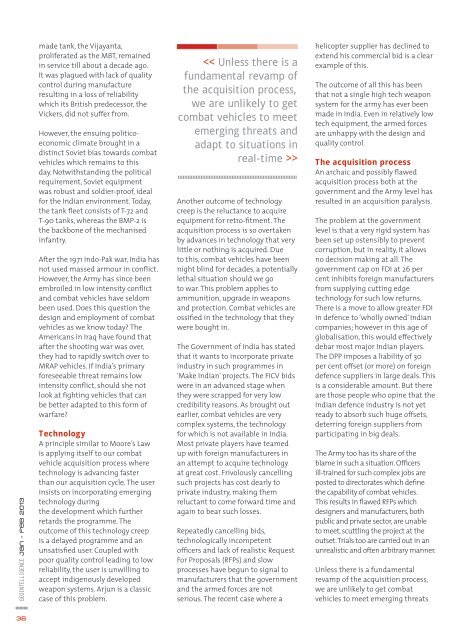Download PDF - Geospatialworld.net
Download PDF - Geospatialworld.net
Download PDF - Geospatialworld.net
You also want an ePaper? Increase the reach of your titles
YUMPU automatically turns print PDFs into web optimized ePapers that Google loves.
GEOINTELLIGENCE Jan jan - – feb Feb 2013 2012made tank, the Vijayanta,proliferated as the MBT, remainedin service till about a decade ago.It was plagued with lack of qualitycontrol during manufactureresulting in a loss of reliabilitywhich its British predecessor, theVickers, did not suffer from.However, the ensuing politicoeconomicclimate brought in adistinct Soviet bias towards combatvehicles which remains to thisday. Notwithstanding the politicalrequirement, Soviet equipmentwas robust and soldier-proof, idealfor the Indian environment. Today,the tank fleet consists of T-72 andT-90 tanks, whereas the BMP-2 isthe backbone of the mechanisedinfantry.After the 1971 Indo-Pak war, India hasnot used massed armour in conflict.However, the Army has since beenembroiled in low intensity conflictand combat vehicles have seldombeen used. Does this question thedesign and employment of combatvehicles as we know today? TheAmericans in Iraq have found thatafter the shooting war was over,they had to rapidly switch over toMRAP vehicles. If India’s primaryforeseeable threat remains lowintensity conflict, should she notlook at fighting vehicles that canbe better adapted to this form ofwarfare?TechnologyA principle similar to Moore’s Lawis applying itself to our combatvehicle acquisition process wheretechnology is advancing fasterthan our acquisition cycle. The userinsists on incorporating emergingtechnology duringthe development which furtherretards the programme. Theoutcome of this technology creepis a delayed programme and anunsatisfied user. Coupled withpoor quality control leading to lowreliability, the user is unwilling toaccept indigenously developedweapon systems. Arjun is a classiccase of this problem.>Another outcome of technologycreep is the reluctance to acquireequipment for retro-fitment. Theacquisition process is so overtakenby advances in technology that verylittle or nothing is acquired. Dueto this, combat vehicles have beennight blind for decades, a potentiallylethal situation should we goto war. This problem applies toammunition, upgrade in weaponsand protection. Combat vehicles areossified in the technology that theywere bought in.The Government of India has statedthat it wants to incorporate privateindustry in such programmes in‘Make Indian’ projects. The FICV bidswere in an advanced stage whenthey were scrapped for very lowcredibility reasons. As brought outearlier, combat vehicles are verycomplex systems, the technologyfor which is not available in India.Most private players have teamedup with foreign manufacturers inan attempt to acquire technologyat great cost. Frivolously cancellingsuch projects has cost dearly toprivate industry, making themreluctant to come forward time andagain to bear such losses.Repeatedly cancelling bids,technologically incompetentofficers and lack of realistic RequestFor Proposals (RFPs) and slowprocesses have begun to signal tomanufacturers that the governmentand the armed forces are notserious. The recent case where ahelicopter supplier has declined toextend his commercial bid is a clearexample of this.The outcome of all this has beenthat not a single high tech weaponsystem for the army has ever beenmade in India. Even in relatively lowtech equipment, the armed forcesare unhappy with the design andquality control.The acquisition processAn archaic and possibly flawedacquisition process both at thegovernment and the Army level hasresulted in an acquisition paralysis.The problem at the governmentlevel is that a very rigid system hasbeen set up ostensibly to preventcorruption, but in reality, it allowsno decision making at all. Thegovernment cap on FDI at 26 percent inhibits foreign manufacturersfrom supplying cutting edgetechnology for such low returns.There is a move to allow greater FDIin defence to ‘wholly owned’ Indiancompanies; however in this age ofglobalisation, this would effectivelydebar most major Indian players.The DPP imposes a liability of 30per cent offset (or more) on foreigndefence suppliers in large deals. Thisis a considerable amount. But thereare those people who opine that theIndian defence industry is not yetready to absorb such huge offsets,deterring foreign suppliers fromparticipating in big deals.The Army too has its share of theblame in such a situation. Officersill-trained for such complex jobs areposted to directorates which defi<strong>net</strong>he capability of combat vehicles.This results in flawed RFPs whichdesigners and manufacturers, bothpublic and private sector, are unableto meet, scuttling the project at theoutset. Trials too are carried out in anunrealistic and often arbitrary manner.Unless there is a fundamentalrevamp of the acquisition process,we are unlikely to get combatvehicles to meet emerging threats36





